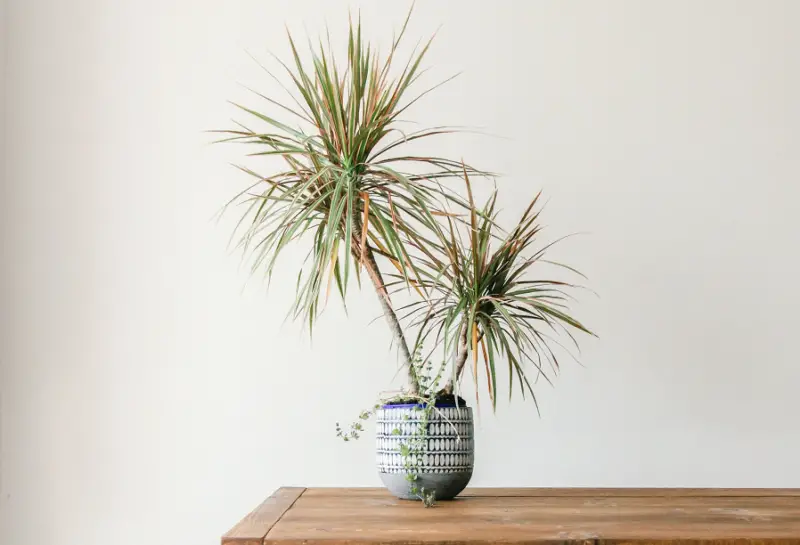Dracaena, a popular genus of tropical broadleaf evergreen shrubs and trees, is widely loved for its stunning appearance and ease of care. Often chosen as a houseplant, dracaena boasts spear- or grass-shaped leaves that extend from thick, cane-like stems. Whether you’re new to plant care or a seasoned gardener, understanding how to properly nurture your dracaena is key to maintaining its health and beauty.
This guide delves into everything you need to know to grow and care for your dracaena plant, covering all aspects from light requirements to common problems and solutions.
Overview of Dracaena

Before we jump into care tips, let’s briefly cover what dracaena is all about. There are more than 100 species in the Dracaena genus, each varying in appearance, but most share common traits like tall, cane-like stems and long, slender leaves. Many dracaena species are native to tropical areas of Africa, Asia, and Australia, and some can grow up to 20 feet tall in their natural habitat. As houseplants, however, they typically remain under 8 feet tall, making them a manageable option for most homes.
Key Characteristics:
- Common Name: Dracaena
- Botanical Name: Dracaena spp.
- Family: Asparagaceae
- Plant Type: Shrub
- Mature Size: 2–10 feet tall, 1–2 feet wide
- Sun Exposure: Partial (bright, indirect light preferred)
- Soil Type: Well-draining, slightly acidic
- Soil pH: Acidic (6.0–6.5)
- Hardiness Zones: USDA zones 10–12
- Toxicity: Toxic to pets (dogs and cats)
Dracaena Plant Care Guide
Light Requirements
Dracaenas thrive in bright, indirect light, making them a perfect choice for indoor environments with filtered sunlight. Although they can tolerate low-light conditions, they will grow more vigorously with brighter exposure. Outdoors, they prefer partial shade or dappled sunlight, but it’s important to avoid harsh afternoon sun, as prolonged exposure can scorch the leaves.
Light Care Tips:
- Place the plant in a spot with plenty of indirect sunlight.
- Avoid direct afternoon sun, especially for delicate species like Dracaena marginata (Dragon Tree).
- Rotate the plant occasionally to ensure even light exposure on all sides.
Soil and Potting Mix
Dracaenas prefer well-draining, slightly acidic soil. For indoor plants, a peat-based commercial potting mix works perfectly, as it provides the right acidity. If planting outdoors in tropical regions, choose soil rich in organic matter to mimic the plant’s natural environment. Proper drainage is crucial, as dracaenas are susceptible to root rot if left in standing water.
Soil Care Tips:
- Use a peat-based potting mix for indoor plants.
- Ensure the soil is well-draining to avoid waterlogging.
- Refresh the top 2-3 inches of potting soil annually to provide fresh nutrients.
Watering Your Dracaena
Watering your dracaena is one of the most important aspects of care. During the growing season (spring to fall), dracaenas require consistent moisture. However, it’s important to let the top inch of soil dry out between waterings to prevent root rot. In winter, dracaenas enter a dormant period, so you should reduce watering to once every two weeks.
Watering Tips:
- Water thoroughly during the growing season, allowing excess water to drain from the pot.
- Let the top inch of soil dry out between waterings.
- Reduce watering frequency in winter to avoid overwatering.
Temperature and Humidity
Dracaenas thrive in temperatures between 70–80°F (21–27°C), which mimics the warm climates they naturally grow in. They can tolerate slight drops in temperature but will struggle in temperatures below 50°F (10°C). Humidity is another important factor, especially during winter when indoor heating can dry out the air. Regular misting or using a humidifier can help maintain the humidity levels your dracaena needs.
Temperature and Humidity Tips:
- Maintain temperatures between 70–80°F for optimal growth.
- Avoid exposing the plant to temperatures below 50°F.
- Use a room humidifier or mist regularly during dry winter months.
Fertilizing Dracaena
Dracaenas benefit from regular feeding during their active growing season. A water-soluble fertilizer formulated for houseplants works best. Apply fertilizer once a month during spring and summer, but stop fertilizing in fall and winter when the plant’s growth slows down.
Fertilizer Tips:
- Feed once a month during the growing season with a water-soluble fertilizer.
- Avoid over-fertilizing, as this can cause nutrient buildup and harm the plant.
- Skip fertilizing in the winter months.
Types of Dracaena
With over 100 species, dracaenas offer a wide variety of appearances. Here are a few popular species to consider for your home:
- Dracaena Fragrans (Corn Plant): Known for its broad, strap-like leaves, this species can grow up to 6 feet indoors.
- Dracaena Draco (Dragon Tree): A slow-growing species with sword-like green leaves, known for its resilience as a houseplant.
- Dracaena Marginata (Dragon Tree): Recognized for its thin, arching leaves that emerge from multiple stems.
- Dracaena Reflexa (Song of India): This species has variegated, narrow leaves with alternating green and chartreuse stripes.
Pruning and Maintenance
Pruning isn’t a requirement for dracaenas, but it can help manage the plant’s shape and size. You can trim yellowing or dead leaves as they appear, and if the plant becomes too tall or leggy, you can cut back the stems to encourage bushier growth. Always prune during the growing season (spring and summer) for the best results.
Pruning Tips:
- Trim yellow or dead leaves as needed.
- Cut back stems if the plant becomes too tall or leggy.
- Prune in spring or summer when the plant is actively growing.
Propagation of Dracaena
Dracaenas are easy to propagate using stem cuttings. The best time to propagate is in spring, when the plant is in its active growth phase. By taking an 8-inch cutting from a healthy stem and planting it in moist potting mix, you can grow a new dracaena in just a few weeks.
Propagation Tips:
- Take an 8-inch stem cutting from a healthy plant.
- Remove leaves from the bottom of the cutting and dip the cut end in rooting hormone.
- Place the cutting in moist potting mix and keep it in bright, indirect light.
- Roots will develop in 2–3 weeks, after which you can repot the new plant.
Common Pests and Problems
While dracaenas are generally low-maintenance, they can still encounter some issues. Pests like mealybugs, spider mites, and aphids are common nuisances, while diseases such as fungal leaf spot can occur if the soil is too moist. Additionally, dracaenas are sensitive to fluoride and salts, which can cause browning of the leaves.
Common Issues and Solutions:
- Browning Leaves: Often caused by fluoride in tap water or a buildup of salts. Use filtered water and deep-water the plant monthly to flush out excess salts.
- Yellowing Leaves: Overwatering is usually the culprit. Reduce the amount of water and ensure the soil drains properly.
- Leaf Scorching: Too much direct sunlight can scorch the leaves. Move the plant to a spot with indirect light or use a sheer curtain to filter the sun.
- Wilting Leaves: Wilting can be caused by a variety of issues, including underwatering, temperature changes, or fungal diseases. Inspect the plant carefully to determine the cause and adjust care accordingly.
Potting and Repotting Dracaena
Dracaenas thrive in large pots with good drainage. When you first plant your dracaena, choose a pot that is slightly larger than the root ball. Repotting should be done every 2–3 years or when the plant becomes root-bound, meaning the roots begin to grow through the drainage holes.
Potting Tips:
- Use a well-draining potting mix and a pot with drainage holes.
- Repot every 2–3 years, or when roots outgrow the pot.
- Replace the top few inches of soil yearly to refresh nutrients.
Conclusion
Dracaenas are a beautiful and low-maintenance choice for any home. By providing the right amount of light, water, and care, you can enjoy the striking foliage of this tropical plant for many years. Whether you choose the towering Dracaena Fragrans or the elegant Dracaena Marginata, this versatile plant is sure to add a touch of nature to your living space. Just remember, proper care is the key to keeping your dracaena happy, healthy, and thriving!






